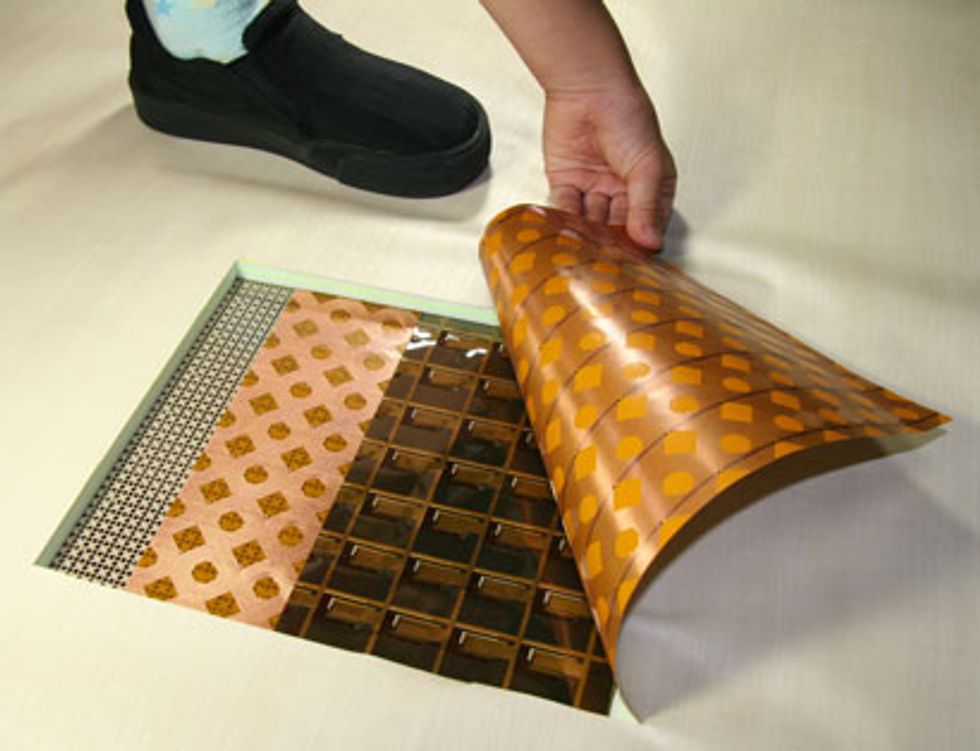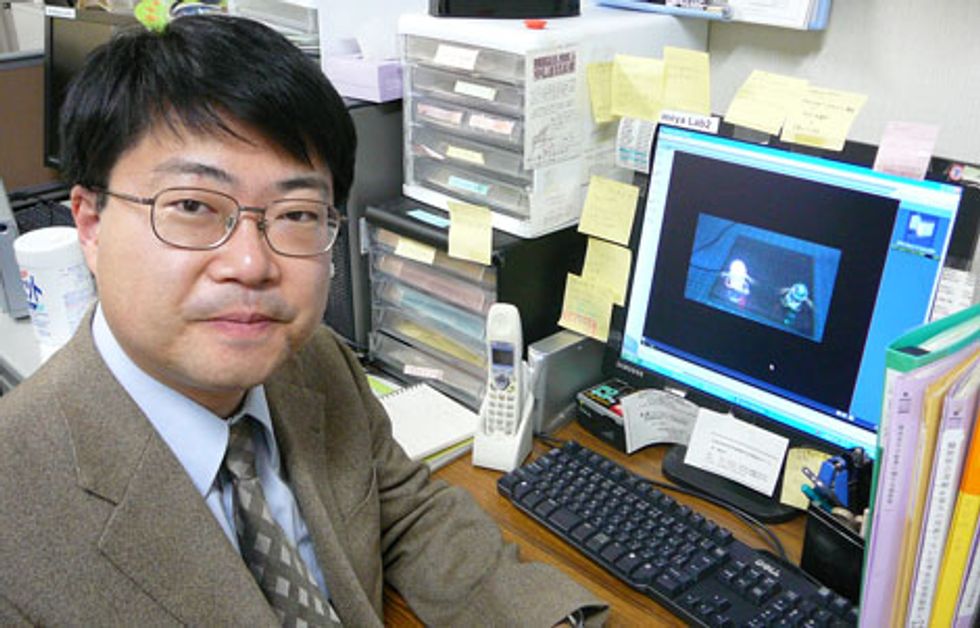11 December 2007—A group of researchers at the University of Tokyo believes it is on the way to freeing us of the spaghetti tangle of wires and cables piled up behind our computer systems and home entertainment centers. Yesterday in Washington, D.C., at the IEEE International Electron Devices Meeting, they presented a low-cost, low-power, large-area smart sheet that could provide wireless power to and high-speed wireless communications among laptops, digital cameras, and other electronics placed on it.
With further improvement, the researchers say, these electronic sheets could be formed into table covers, desk covers, or wallpaper, or be embedded into the floor, and could allow hundreds, even thousands, of devices to communicate with one another with a level of security better than can be achieved by Bluetooth, Wi-Fi, or other wireless technologies. The sheet could also deliver power directly to devices, the researchers say, replacing cables and power cords, along with their connectors and plugs.
The communications sheet originates from a series of technology developments in large-area electronics made by researchers at the University of Tokyo’s School of Engineering. Starting in 2003, they created an artificial skin for robots composed of a plastic film incorporating a printed matrix of flexible pressure sensors made from organic semiconductor-based transistors. In 2006, they made a wireless power-transmission sheet that transferred power to objects placed anywhere on the sheet through inductive coils in the sheet and the receiving device. The power sheet routed the power to the right spots through a combination of organic transistors and plastic microelectromechanical systems (MEMS) switches.
”Our research has progressed through large-area sensors and large-area actuators, and then we combined them to realize wireless power transmission,” explains Takao Someya, associate professor at the University of Tokyo’s Quantum Phase Electronics Center, who led the research together with associate researcher Tsuyoshi Sekitani. ”So we decided the next step should realize communications between devices.”
Someya says enabling a myriad of devices to talk to one another will be essential in the coming era of ubiquitous computing, when most household objects, gadgets, and appliances are expected to interact.
ELECTRIC FLOOR MAT
A plastic sheet capable of wirelessly transmitting power to objects placed on it. It’s one of two components of the University of Tokyo’s smart sheet.
”The question is, How will they do this and how can we transmit power to them?” says Someya. Wireless communications is convenient, but the power consumption for a wireless LAN running thousands of devices would be huge, and managing the communications among so many objects would be an onerous task, he says. Wired communications is power efficient and provides a measure of security, but imagine the mess of wires needed to link even 100 items.
”So with the communications sheet, we are proposing a mixture of wired and wireless communications, where communication is carried out over wires except for the last 1 millimeter, which is done wirelessly,” explains Someya. ”If the wireless connection is this short, the power does not dissipate, and it does not require a direct contact. So no cable or plug is needed.”
The communications sheet, measuring 21 by 21 centimeters, is formed from a matrix of wires, transistors, sensors, MEMS switches, and nonvolatile ferroelectric random access memory (FeRAM), all made from organic materials, which allows them to be printed in layers onto the sheet’s flexible plastic substrate. These components are arranged to form an array of 8 by 8 communication cells, with each cell composed of a spiral sensor coil, a MEMS switch, and a three-transistor FeRAM.
When a device fitted with a transmitter coil is laid down on the sheet, the nearest coil in the sheet senses its location via electromagnetic coupling and dynamically sets up a communications route through the sheet, by means of MEMS switches, to a second coil-fitted device. The communications path is then stored in the nonvolatile memory. This results, according to Someya, in the world’s lowest power consumption for wireless communications: 107 picojoules per bit at 100 kilobits per second.
By combining the group’s wireless power-transmission sheet with the communications sheet, power from an outside source could also be fed to communicating devices in similar fashion. Currently, the researchers have achieved a power transfer of more than 40 watts through a single coil, ”enough to power a small notebook computer,” says Someya. ”And if we add more coils to a device, then we can significantly increase that figure.”
PLASTIC MAN
Takao Someya, associate professor at the University of Tokyo and head of the lab that developed the wireless communications and wireless power sheet.
Because all the components are formed from organic materials, they can be applied in solution form using inkjet printing onto flexible substrates. This makes roll-to-roll production of smart sheets a relatively inexpensive possibility.
A key breakthrough that made the communication sheet possible was the ability to greatly extend the lifetime of the organic FeRAM when it is exposed to air, which had typically been measured in mere days. But by incorporating a material originally produced for ultrasound transducers by Toray Industries, called poly(vinylidene fluoride/trifluoroethylene), the Tokyo researchers extended the device’s lifetime to more than five months, says Someya. ”We can extend this further by a factor of 10.”
Someya expects that the first practical application of the technology will likely be in the form of desk covers. ”This will show what the technology can do,” he says, ”and it will become available not far in the future.” Given the increasing employment of Bluetooth and wireless LANs, in 10 years ”the technology will really come into its own when the number of electronic objects around us rises into the thousands,” says Someya.
About the Author
John Boyd writes about science and technology from Japan.

